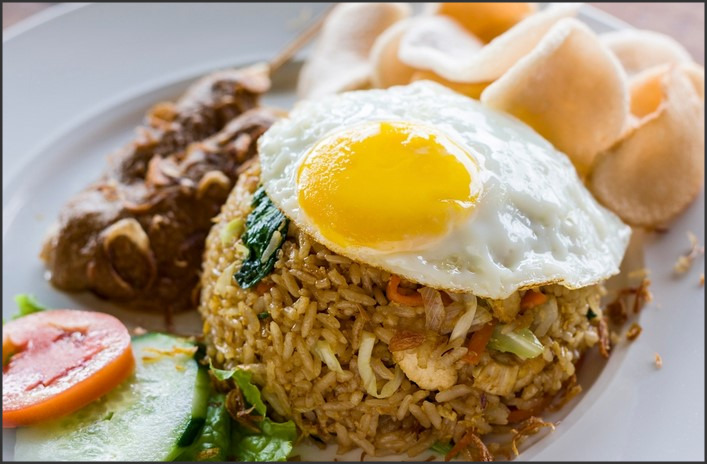
Indonesia is a country of many cultures, and its cuisine is no exception. With over 17,000 islands, the archipelago is home to a variety of culinary delights, from the spicy sambals of Sumatra to the sweet and savory dishes of Java. One of the most beloved dishes in Indonesia is the national dish, known as nasi goreng. This traditional fried rice dish is a staple of Indonesian cuisine, and it is enjoyed by locals and visitors alike. In this article, we will explore the history and ingredients of nasi goreng, as well as some of the variations that can be found throughout the archipelago. We will also discuss the importance of nasi goreng in Indonesian culture and how it has become a beloved national dish.
Exploring the Regional Variations of Indonesia’s National Dish: Nasi Goreng
Nasi Goreng is a beloved national dish of Indonesia, and it is enjoyed by people of all ages. This traditional dish is a fried rice dish that is typically served with a variety of accompaniments, such as eggs, vegetables, and meats. While the basic recipe for Nasi Goreng is the same throughout Indonesia, there are regional variations that make the dish unique to each area.
In East Java, Nasi Goreng is often served with a side of sambal, a spicy condiment made from chili peppers, garlic, and other spices. This version of the dish is known as Nasi Goreng Jawa, and it is a popular breakfast dish. In Central Java, Nasi Goreng is served with a side of tempeh, a fermented soybean cake. This version of the dish is known as Nasi Goreng Tempeh, and it is often served with a side of pickled vegetables.
In West Java, Nasi Goreng is served with a side of sambal terasi, a condiment made from shrimp paste and chili peppers. This version of the dish is known as Nasi Goreng Sambal Terasi, and it is often served with a side of fried shallots. In Bali, Nasi Goreng is served with a side of sambal matah, a condiment made from shallots, garlic, and chili peppers. This version of the dish is known as Nasi Goreng Sambal Matah, and it is often served with a side of fried peanuts.
In Sumatra, Nasi Goreng is served with a side of sambal ijo, a condiment made from green chili peppers and other spices. This version of the dish is known as Nasi Goreng Sambal Ijo, and it is often served with a side of fried shallots and peanuts. In Sulawesi, Nasi Goreng is served with a side of sambal roa, a condiment made from chili peppers, garlic, and other spices. This version of the dish is known as Nasi Goreng Sambal Roa, and it is often served with a side of fried shallots and peanuts.
No matter where you are in Indonesia, you can find a delicious version of Nasi Goreng. Each region has its own unique take on the classic dish, making it a truly unique culinary experience. Whether you are looking for a spicy kick or a milder flavor, there is a version of Nasi Goreng that is sure to please your taste buds.
The History and Cultural Significance of Indonesia’s National Dish: Rendang
Rendang is a traditional Indonesian dish that has been enjoyed for centuries. It is a rich and flavorful curry-like dish that is made with a variety of spices, coconut milk, and meat. Rendang is considered to be the national dish of Indonesia and is a popular dish throughout the country.
Rendang originated in the Minangkabau region of West Sumatra, Indonesia. It is believed to have been created by the Minangkabau people as a way to preserve meat in the hot and humid climate of the region. The dish is made by slowly simmering the meat in a mixture of spices, coconut milk, and other ingredients. The slow cooking process allows the flavors to meld together and creates a rich and flavorful dish.
Rendang is a popular dish throughout Indonesia and is served at many special occasions. It is often served at weddings, religious ceremonies, and other important events. The dish is also served at festivals and other celebrations. It is a symbol of hospitality and is often served to guests as a sign of respect.
Rendang is a dish that is deeply rooted in Indonesian culture and history. It is a symbol of the country’s rich culinary heritage and is a reminder of the importance of preserving traditional recipes. The dish is also a reminder of the importance of using local ingredients and spices to create flavorful dishes.
Rendang is a dish that is enjoyed by people of all ages and backgrounds. It is a dish that is enjoyed by both locals and tourists alike. The dish is a reminder of the importance of preserving traditional recipes and the importance of using local ingredients and spices to create flavorful dishes. Rendang is a dish that is deeply rooted in Indonesian culture and history and is a symbol of the country’s rich culinary heritage.
Conclusion
Indonesia is a country with a rich and diverse culinary heritage. From the spicy sambals of Sumatra to the sweet and savory dishes of Java, the country’s national dishes are a reflection of its unique culture and history. From the traditional dishes of the archipelago to the modern fusion cuisine, Indonesia’s national dishes are a testament to the country’s culinary creativity and diversity. Whether you’re looking for a quick snack or a full-course meal, Indonesia’s national dishes are sure to satisfy your appetite.